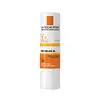La Roche-Posay Anthelios SPF 50+ Stick For Sensitive Lips Versus Kiehl's Facial Fuel No-Shine Moisturizing Lip Balm
What's inside
What's inside
 Key Ingredients
Key Ingredients

 Benefits
Benefits

 Concerns
Concerns

 Ingredients Side-by-side
Ingredients Side-by-side

Ricinus Communis Seed Oil
MaskingIsopropyl Palmitate
EmollientPolyethylene
AbrasiveIsohexadecane
EmollientHomosalate
Skin ConditioningEthylhexyl Triazone
UV AbsorberOctocrylene
UV AbsorberButyl Methoxydibenzoylmethane
UV AbsorberDrometrizole Trisiloxane
UV AbsorberParaffin
PerfumingTheobroma Cacao Seed Butter
EmollientButyrospermum Parkii Butter
Skin ConditioningBis-Ethylhexyloxyphenol Methoxyphenyl Triazine
Skin ConditioningCera Microcristallina
Emulsion StabilisingCitric Acid
BufferingGlycine Soja Oil
EmollientSynthetic Wax
AbrasiveTocopherol
AntioxidantParfum
MaskingRicinus Communis Seed Oil, Isopropyl Palmitate, Polyethylene, Isohexadecane, Homosalate, Ethylhexyl Triazone, Octocrylene, Butyl Methoxydibenzoylmethane, Drometrizole Trisiloxane, Paraffin, Theobroma Cacao Seed Butter, Butyrospermum Parkii Butter, Bis-Ethylhexyloxyphenol Methoxyphenyl Triazine, Cera Microcristallina, Citric Acid, Glycine Soja Oil, Synthetic Wax, Tocopherol, Parfum
Squalane
EmollientEthylhexyl Palmitate
EmollientCera Microcristallina
Emulsion StabilisingPolyethylene
AbrasiveIsopropyl Palmitate
EmollientPrunus Armeniaca Kernel Oil
MaskingButyrospermum Parkii Butter
Skin ConditioningParaffin
PerfumingSynthetic Wax
AbrasiveMentha Piperita Oil
MaskingSimmondsia Chinensis Butter
Skin ConditioningPrunus Amygdalus Dulcis Oil
Skin ConditioningSodium Saccharin
MaskingLimonene
PerfumingLinalool
PerfumingCitric Acid
BufferingSqualane, Ethylhexyl Palmitate, Cera Microcristallina, Polyethylene, Isopropyl Palmitate, Prunus Armeniaca Kernel Oil, Butyrospermum Parkii Butter, Paraffin, Synthetic Wax, Mentha Piperita Oil, Simmondsia Chinensis Butter, Prunus Amygdalus Dulcis Oil, Sodium Saccharin, Limonene, Linalool, Citric Acid
Ingredients Explained
These ingredients are found in both products.
Ingredients higher up in an ingredient list are typically present in a larger amount.
This ingredient is also known as shea butter. It is an effective skin hydrator and emollient.
Emollients help soothe and soften your skin. It does this by creating a protective film on your skin. This barrier helps trap moisture and keeps your skin hydrated. Emollients may be effective at treating dry or itchy skin.
Shea butter is rich in antioxidants. Antioxidants help fight free-radicals, or molecules that may harm the body. It is also full of fatty acids including stearic acid and linoleic acid. These acids help replenish the skin and keep skin moisturized.
While Shea Butter has an SPF rating of about 3-4, it is not a sunscreen replacement.
Shea butter may not be fungal acne safe. We recommend speaking with a professional if you have any concerns.
Learn more about Butyrospermum Parkii ButterCera Microcristallina isn't fungal acne safe.
Citric Acid is an alpha hydroxy acid (AHA) naturally found in citrus fruits like oranges, lemons, and limes.
Like other AHAs, citric acid can exfoliate skin by breaking down the bonds that hold dead skin cells together. This helps reveal smoother and brighter skin underneath.
However, this exfoliating effect only happens at high concentrations (20%) which can be hard to find in cosmetic products.
Due to this, citric acid is usually included in small amounts as a pH adjuster. This helps keep products slightly more acidic and compatible with skin's natural pH.
In skincare formulas, citric acid can:
While it can provide some skin benefits, research shows lactic acid and glycolic acid are generally more effective and less irritating exfoliants.
Most citric acid used in skincare today is made by fermenting sugars (usually from molasses). This synthetic version is identical to the natural citrus form but easier to stabilize and use in formulations.
Read more about some other popular AHA's here:
Learn more about Citric AcidIsopropyl Palmitate is a texture enhancer and emollient. It is an ester of isopropyl alcohol and palmitic acid.
Palmitates are emollients. Emollients help keep your skin soft and smooth by creating a barrier that traps moisture in.
When added to cosmetics, Isopropyl Palmitate creates a silky texture and improves spreadability.
Isopropyl Palmitate may not be fungal acne safe. It can worsen acne prone skin.
Learn more about Isopropyl PalmitateParaffin is a solid created from petroleum. The term 'paraffin' can also refer to either
petroleum jelly or mineral oil.
It has natural occlusive properties which can worsen oily skin. Due to its petrolatum base, this ingredient is not fungal-acne safe.
Polyethylene is a synthetic ingredient that helps the skin retain moisture. It is a polymer.
It is also typically used within product formulations to help bind solid ingredients together and thicken oil-based ingredients. When added to balms and emulsions, it helps increase the melting point temperature.
Synthetic Wax is created from fossil fuels such as natural gas. It is used to enhance texture, adjust pH, and as an occlusive.
It may also be used as an abrasive ingredient to exfoliate the skin.
Synthetic Wax may not be fungal acne safe.
Learn more about Synthetic Wax